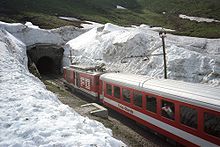Furka Summit Tunnel

FO train at Muttbach-Belvédère portal, 1981.
|
|
| Overview | |
|---|---|
| Line |
Furka Oberalp Bahn (FO) (to 1981) Furka Cogwheel Steam Railway (DFB) (since 2000) |
| Location | Valais / Uri, Switzerland |
| Status | Open |
| Start |
Furka, Uri 46°34′34″N 8°25′42″E / 46.57611°N 8.42833°ECoordinates: 46°34′34″N 8°25′42″E / 46.57611°N 8.42833°E |
| End |
Muttbach-Belvédère, Valais 46°34′02″N 8°24′14″E / 46.56722°N 8.40389°E |
| Operation | |
| Opened | 3 July 1926 |
| Closed | 11 October 1981 |
| Reopened | 14 July 2000 |
| Owner | Furka Cogwheel Steam Railway |
| Operator | Furka Cogwheel Steam Railway |
| Traffic | Train |
| Character | Passenger |
| Technical | |
| Length | 1,858 m (6,096 ft) |
| Line length | 1,858 m (6,096 ft) |
| No. of tracks | Single track |
| Track gauge | 1,000 mm (3 ft 3 3⁄8 in) metre gauge |
| Electrified |
Overhead catenary, 11 kV AC 16 2/3 Hz (1942-1981) |
| Highest elevation | 2,160 m (7,090 ft) above the Sea |
The Furka Summit Tunnel (German: Furka-Scheiteltunnel) is a 1,858 metres (6,096 ft) long railway tunnel in southern Switzerland. It lies at an altitude of 2,160 metres (7,090 ft). The summit tunnel was completed in 1925, and first opened on 3 July 1926. It links the Furka railway station, in Uri, with the Muttbach-Belvédère halting point, in Valais.
Until 1982, when the summit tunnel was replaced by the Furka Base Tunnel, the railway line passing through the summit tunnel was part of the Furka Oberalp Bahn (FO). However, that line, which, along with the summit tunnel, was closed in 1981 and reopened in 2000, is now part of the Furka Cogwheel Steam Railway, a heritage railway operating in summer only.
Between 1926 and 1981, the FO allocated three schedule periods to the line passing through the summit tunnel. The summer schedule corresponded with the then European summer timetable. The other seasons, covered by the then European winter timetable, were divided by the FO into autumn and winter periods, because traffic over the Furka Pass could be operated only until mid October.
As soon as snow started falling, the FO had to be ready to place individual items of rolling stock on either side of the Furka, according to demand. Then, during the years commencing with electrification of the line in 1942, the electrical contact wire had to be dismantled over a nearly 15 kilometres (9.3 mi) long section of line, and the line made "avalanche ready". Everything more than 1 metre (3 ft 3 in) above ground level had to be removed, necessitating a huge annual expenditure.
The Steffenbach bridge, on the Uri side of the summit tunnel, was built initially as a viaduct. However, as early as the first year following its construction, it became the victim of an avalanche. A folding bridge was then installed in its place. To this day, the 30 tonne folding bridge, which can carry a payload of up to 200 tonnes (200 long tons; 220 short tons), is made safe each autumn by drawing it back to its abutments, in three pieces. Originally it took 20 men 8 hours to set it up or withdraw it but with the installation of hydraulic winches after the restoration of the railway it takes 10 men six hours.
...
Wikipedia
